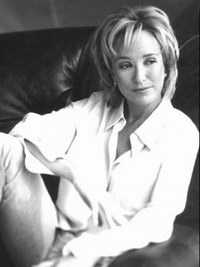b. Tanya Denise Tucker, 10 October 1958, Seminole, Texas, USA. Tucker's father, Beau, a construction worker, and her mother, Juanita, encouraged her fledgling musical talents. Her early years were spent in Wilcox, Arizona, before moving to Phoenix in 1967. Her father booked her to perform with visiting country stars on stage at local fairs. Never one to consider that some songs might be too old for her, she was singing "You Ain't Woman Enough" before she was 13.
The family moved to St. George, Utah, and her mother impressed the producer of the Robert Redford film Jeremiah Johnson, which led to Tucker (and her horse!) being featured. To further their daughter's career, they moved to Las Vegas, where Beau financed a demo tape. In 1972 Tucker was signed to Columbia Records in Nashville by producer Billy Sherrill, although she disliked his choice of song - "The Happiest Girl In The Whole USA", later a hit for Donna Fargo. Subsequently, she made the US country Top 10 with Alex Harvey's "Delta Dawn", and did equally well with the double-sided "Jamestown Ferry"/"Love's The Answer", and then had a US country number 1 with "What's Your Mama's Name?", a story song with a twist in its last line.
"Blood Red And Goin' Down", the title referring to a Georgia sunset, was about a daughter watching her father kill her cheating mother, while "Would You Lay With Me (In A Field Of Stone)?" was an adult love song, written by David Allen Coe for his brother's wedding. The young Tucker became a country star, was featured on the cover of Rolling Stone, and, through 200 appearances a year, developed a powerful, if precocious, stage presence. Moving to MCA on her 16th birthday, she was determined to make records that were in keeping with the sophisticated country rock of the Eagles, and she topped the country charts with "Lizzie And The Rainman" (also US Top 40), which was based on the Burt Lancaster film The Rainmaker, "San Antonio Stroll" and "Here's Some Love".
In 1978 she wrote and recorded "Save Me", an ecologically inspired single about seal culls on Canada's Magdalen Islands. The provocative cover picture of TNT caused controversy, but it certainly represented a different approach for a country star. She was booed on the Grand Ole Opry for performing raucous rock 'n' roll. Tear Me Apart was made with the producer-of-the-moment, Mike Chapman, and included a hoarse segue of "San Francisco" with "I Left My Heart In San Francisco".
Neither album sold as well as expected, but Tucker found herself in gossip columns as a result of her stormy relationship with Glen Campbell. She commented: "Men are supposed to slow down after 40, but it's the opposite with Glen", and their duets included a revival of Bobby Darin's "Dream Lover". The dream was over when Campbell knocked out her front teeth. Hardly surprisingly, she kept her mouth shut for the glum cover of her next album, Changes.
As fate would have it, they were to find themselves on the same label, Capitol, and Tucker's career was revitalized with Girls Like Me, an album that spawned four Top 10 country singles. In 1988 she had three number 1 country singles - "I Won't Take Less Than Your Love" (with Paul Davis and Paul Overstreet ), "If It Don't Come Easy" and "Strong Enough To Bend" - but it was also the year in which she entered the Betty Ford clinic for cocaine and alcohol addiction. Tucker has only written sporadically, but she co-wrote Hank Williams Jnr.'s "Leave Them Boys Alone".
After many years in country music her contributions were finally rewarded by the Country Music Association when they voted her Female Vocalist Of The Year in 1991, although she had to miss attending the event, having just had her second child. Her country chart successes included two number 2s with "Down To My Last Teardrop" and "(Without You) What Do I Do About Me". In 1992 further hits included "Some Kind Of Trouble", but more awards were not forthcoming, although she did receive a nomination for What Do I Do About Me as Album Of The Year. The title track of her 1995 release Fire To Fire was a duet with Willie Nelson, but the album was marred by weak song selection. In 1996 her autobiography was published; among the contents were details of her volatile relationship with Glen Campbell. She returned to form in 1997 with Complicated..
Source: http://artist.country.com/cmt/art/search/art.bios.jhtml?ai_id=150214
